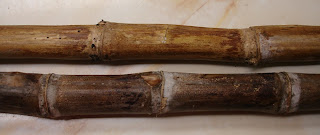The mill was hewn from Florida limestone, brick, and wood. The machinery for the mill was brought in by ship around Cape Florida from New York and included a steam engine used to process the sugar and large kettles to boil the juices.
The sugar cane was processed by crushing through these huge metal rollers which squeezed the juice from the canes. Sugar cane is a true perennial grass and grows 6 to 19 feet tall. The tough fibrous stalks are full of the sugars.
Part of the steam boiler brought from New York.
Remains of several kettles where the cane juice was boiled.
A couple of sugar cane stalks I got at my local produce market to show you. The dried sugar cane stalks are beautiful.
Today sugar cane is the largest crop in the world and is grown in 90 countries. Approximately 1.6 billion tons are grown, the top producer being Brazil where much of the juice is fermented to produce ethanol used as a substitute for gasoline. The remaining parts of the cane called bagasse a biomass which can be burned by steam to produce electricity. Half of all sugar cane is still harvested by hand. After six to seven months of growing the fields are set on fire where the leaves are burned away and later the cane is cut down with a machete. A skilled worker can cut up to 1100 pounds of cane in an hour. A simple trip to the Yulee Sugar Mill Ruins and reading about sugar cane production, ethanol, and bagassee has made me realize I have much to learn about world cultures and economies. This post is part of the Mud Colony what's happening in the studio. Not really pottery related, but definitely inspirational. Thanks for reading and for all your comments.








What a fascinating post, with neat photos too! Now I want to learn more.....thanks!
ReplyDeleteInteresting post. I like the idea of it being used as an energy source and not for human consumption. I had recently read that if sugar were discovered today, it would be labeled a poison by the FDA.
ReplyDeleteVery interesting post. Using sugar cane for fuel has done a lot for boosting the Brazilian economy. I guess they don't have as many politicians invested in oil companies.
ReplyDeleteHey you could have been a 7th grade teacher on a field trip! It was great to go along with you and learn all about sugar cane! Seriously, thanks!
ReplyDeleteinteresting....there are a lot of possibilities for sugar rather then just for consumption. ThanIt is always fun to get to go with my blogger friends to places I will probably never have the opportunity to go to.
ReplyDeleteMy 2 grandfathers immigrated from Korea to Hawaii to work in the sugar cane fields. One died a millionaire after investing in real estate, whereas the other grandfather died a pauper.
ReplyDeleteThey make ethanol out of sugar cane too? A good part of the midwestern corn crops are made into ethanol. It's kinda scary that food products are being converted to fuel like that!
ReplyDeleteVery interesting and informative I even showed it to Mountain Man as he enjoys reading about ruins as well as learning things :)
ReplyDeleteStunning looking ruin. Amazing the things which ethanol is being made out of now. Not precisely kind to the environment often though - lots of the crops in question need HUGE amounts of water to mature. Damned if we do, and damned if we don't.
ReplyDeleteThis comment has been removed by a blog administrator.
ReplyDeleteHi Suzi, thanks, I can't believe how much I learn just from the research for my posts.
ReplyDeleteHi Patti, thanks, a poison, yikes, glad I don't eat much of it. Ha.
Hi Lori, thanks, yes some countries are doing some good for their residents and their environment.
Hi Barbara, thanks, at one time I wanted to be a teacher, but then life took over. Ha.
Hi Dee, thanks, it is kind of fun learning about other areas of the country, we hope to travel again some day.
Hi Gigi, thanks, oh how interesting about your grandfathers, one rich and the other poor, they say you can't take it with you though.
Hi Ms. Sparrow, thanks, yeah and still the fuel isn't any cheaper, we just can't win.
Hi Willow, thanks, it's amazing what was built so long ago and how the machinery came from so far away by ship.
Hi Elephant's Child, thanks, I think they grow most of the cane in climates that have enough natural rainfall to sustain it, I can't imagine irrigating all that land.
That was a fascinating post and reminded me of visiting an historical plantation in Antigua on our honeymoon. I remember then being jarred by all the implications of slavery. Growing up in Ireland our awareness of the whole slavery history wasn't immense and most history we learnt was about the struggle between england and ireland yadayadayada. Thank you for sharing - loved it!
ReplyDeleteThat was a fascinating post and reminded me of visiting an historical plantation in Antigua on our honeymoon. I remember then being jarred by all the implications of slavery. Growing up in Ireland our awareness of the whole slavery history wasn't immense and most history we learnt was about the struggle between england and ireland yadayadayada. Thank you for sharing - loved it!
ReplyDelete